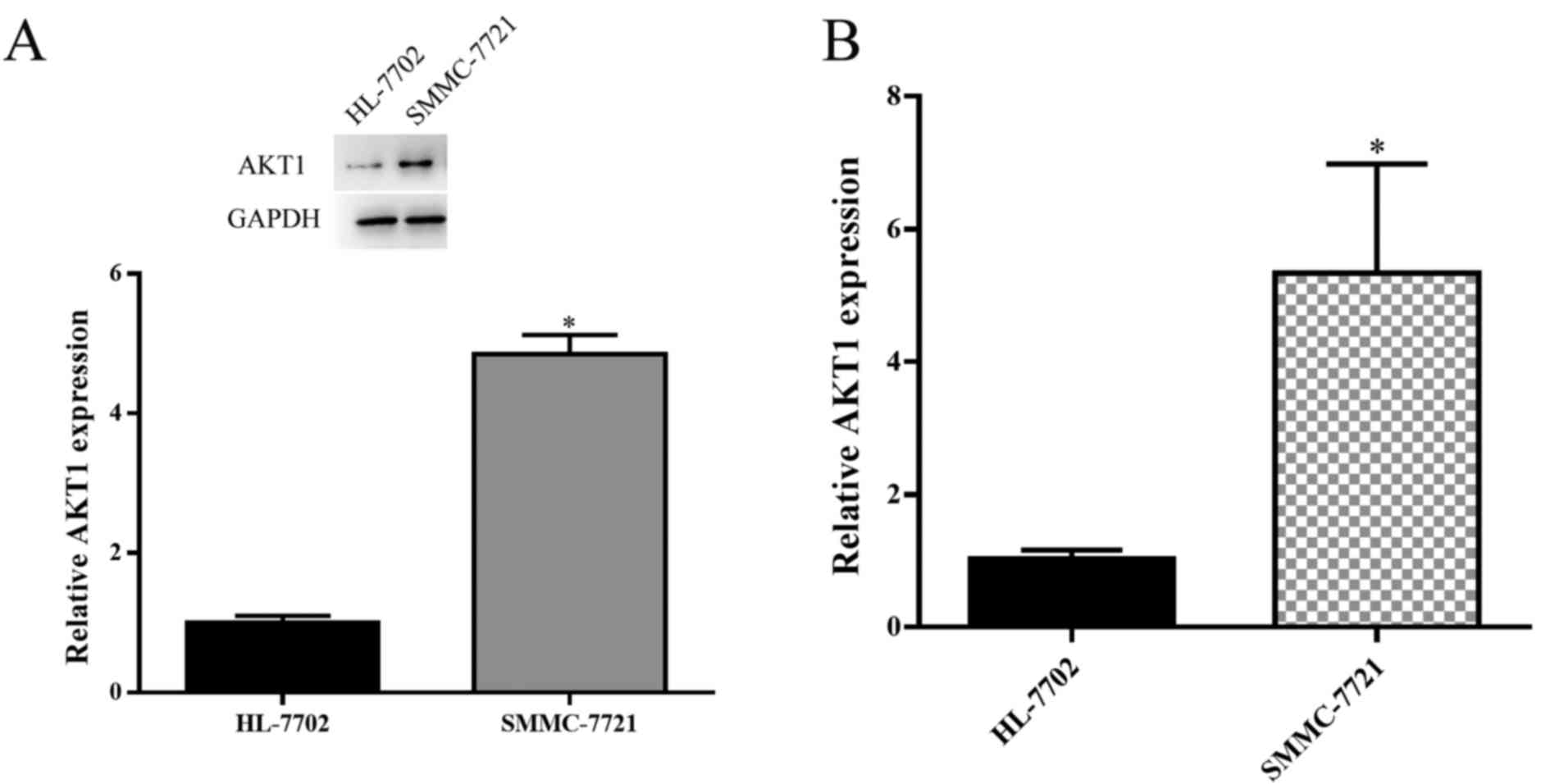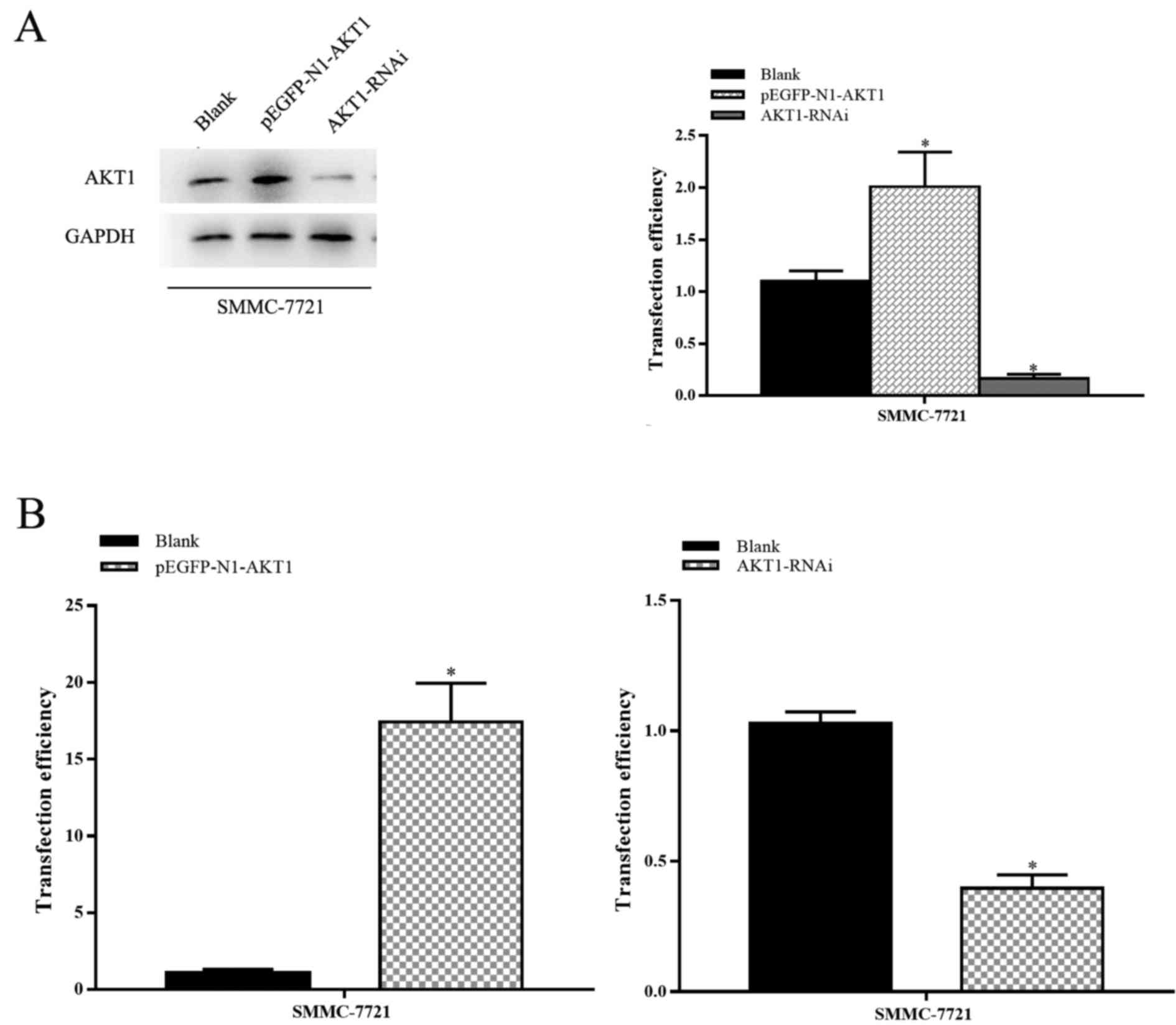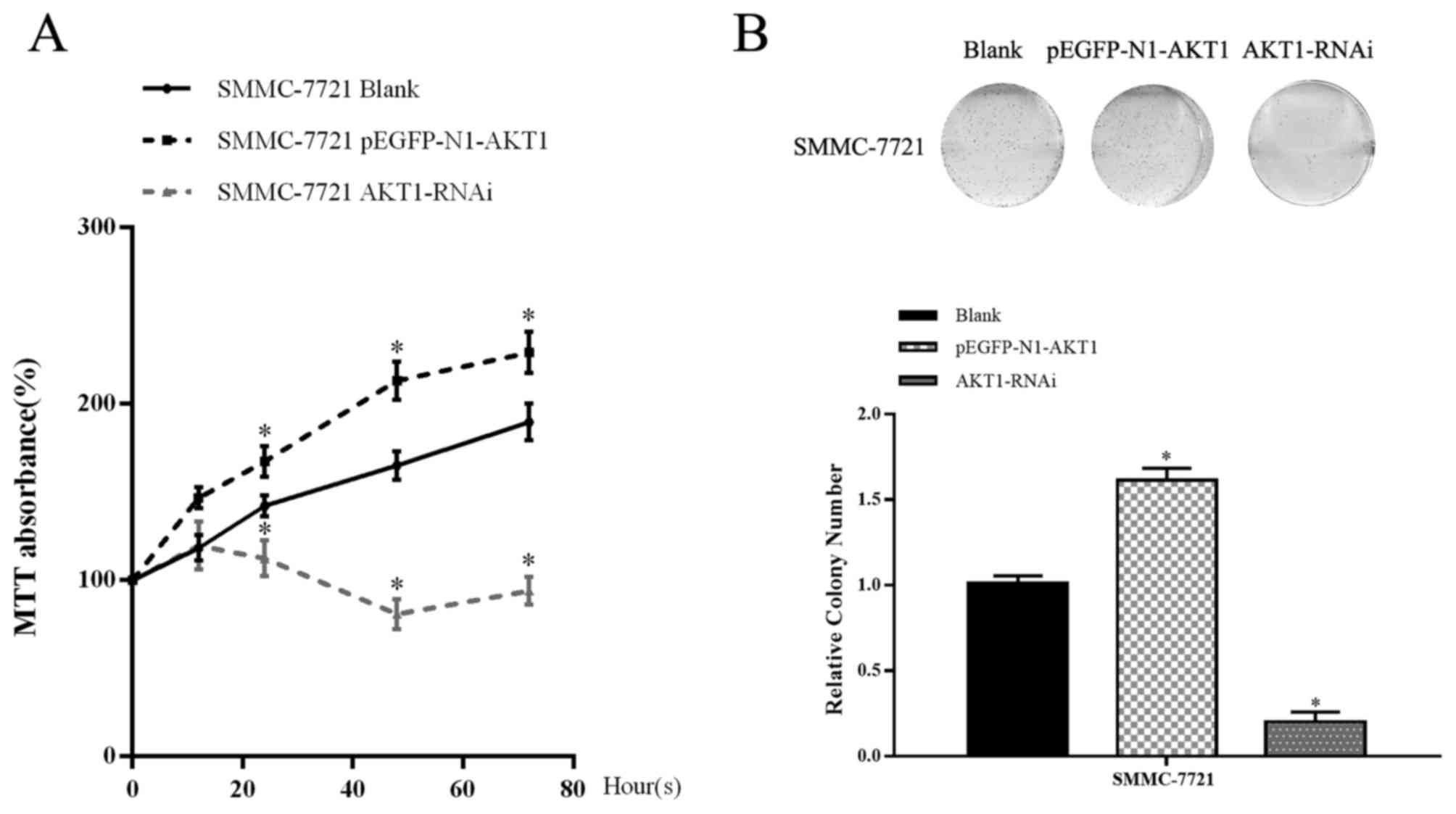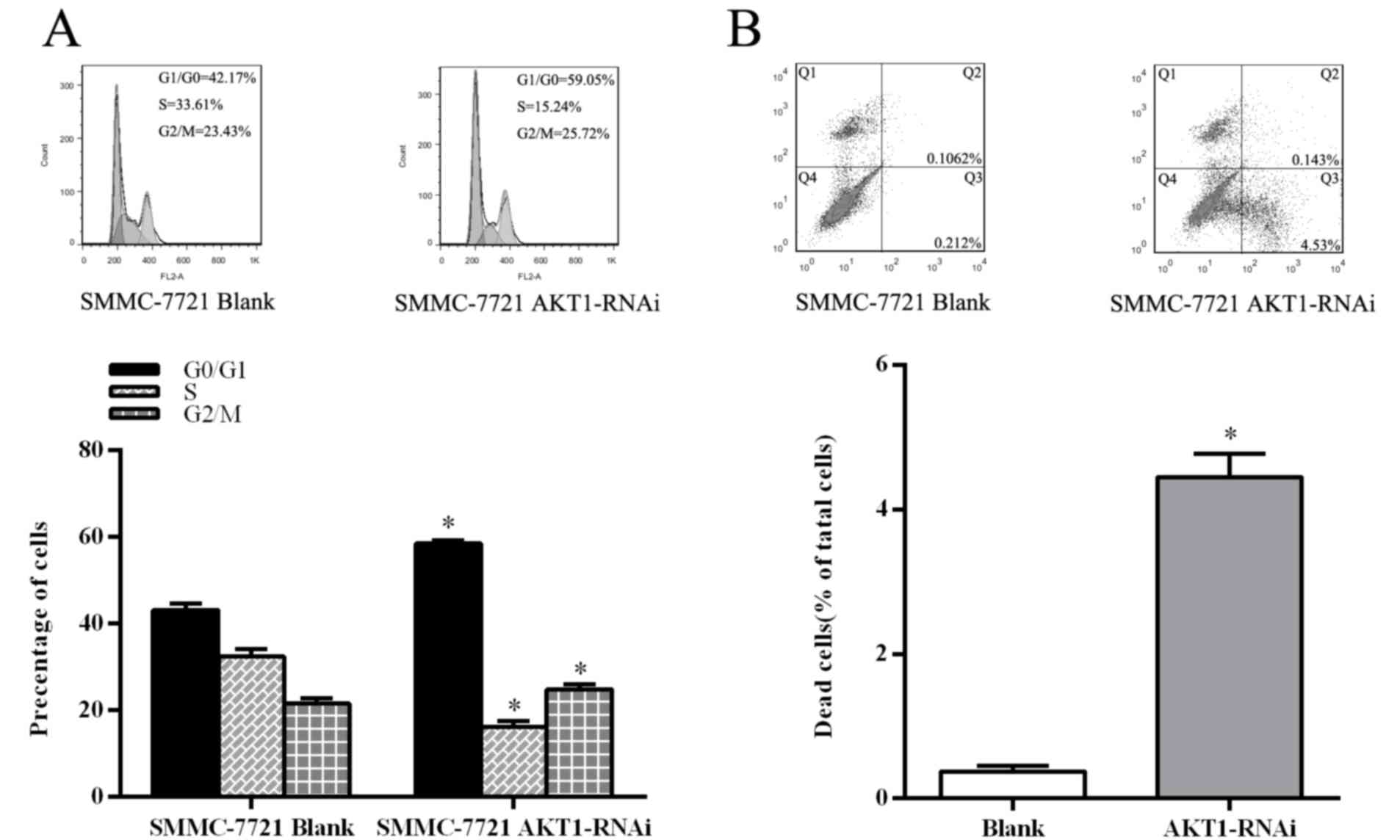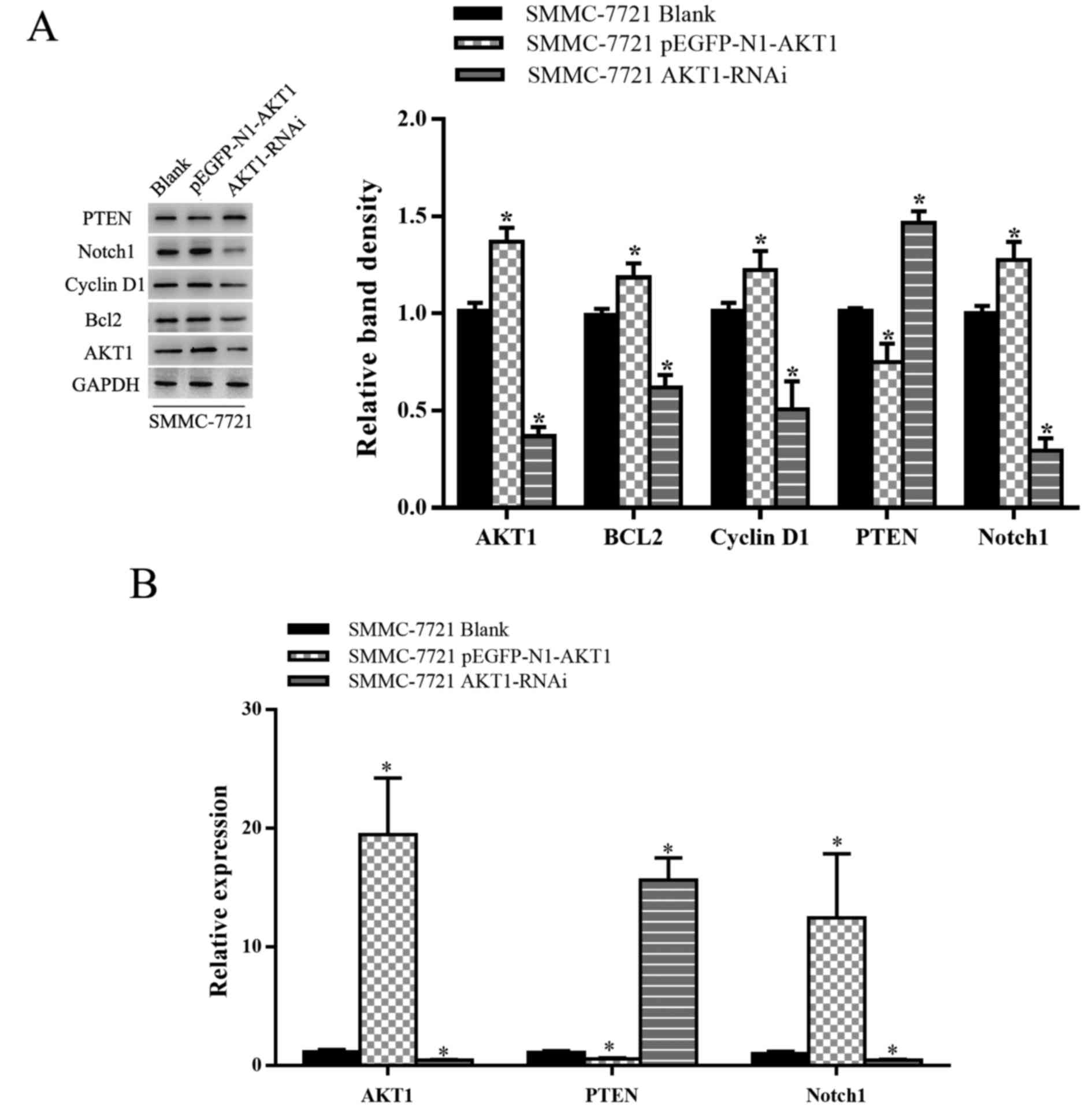Differential regulation of AKT1 contributes to survival and proliferation in hepatocellular carcinoma cells by mediating Notch1 expression
- Authors:
- Published online on: March 7, 2018 https://doi.org/10.3892/ol.2018.8193
- Pages: 6857-6864
-
Copyright: © Chen et al. This is an open access article distributed under the terms of Creative Commons Attribution License.
Abstract
Introduction
Primary liver cancer, which consists mainly of hepatocellular carcinoma (HCC), is the third-leading cause of cancer mortality worldwide, following lung and stomach cancer, owing to its poor prognosis and frequent relapse and metastasis (1,2). Although much is already known about the major pathogenic factors behind HCC, including chronic hepatitis B and hepatitis C infection (3,4), the definitive mechanisms behind HCC have not been elucidated. Only 30–40% of patients with HCC are eligible for potentially radical therapies (5), meaning the overall survival rate of patients with HCC remains low. Therefore, the identification of novel therapeutic targets to improve and develop treatment strategies for HCC.
The phosphoinositide 3-kinase (PI3K)/RAC seine/threonine-protein kinase (AKT)/mechanistic target of rapamycin (mTOR) signaling pathway is a promising therapeutic target owing to its frequent dysregulation in HCC and the critical functions it has in regulating cell survival, proliferation, apoptosis, migration and angiogenesis through phosphorylation of distinct protein substrates (6,7). AKT is a key molecule in the PI3K/AKT/mTOR signaling pathway, which has been shown to serve notable functions in the regulation of cell viability and to be closely associated with a variety of disorders caused by dysfunctional cellular proliferation (8,9). Three isoforms of AKT (AKT1, AKT2, and AKT3), which share >80% sequence homology, have been identified in mammals (10,11). It has been reported that overexpression of AKT is associated with decreased disease-free survival rates and development of primary carcinomas of the prostate, breast and ovary (12,13). However, the action of individual AKT isoforms in different molecular subtypes of HCC has not been extensively evaluated. Lee et al (14) revealed that AKT1 serves a critical function in angiogenesis; AKT1 also has a crucial effect on cell survival (14–17). However, the precise molecular mechanisms by which AKT1 promotes cell proliferation and regulates apoptosis (18,19) remain largely unclear.
High expression of activated AKT can be detected in HCC, and AKT may promote cell proliferation and regulation of cells apoptosis in HCC (20,21). The present study confirmed a potential function for AKT1 in promoting proliferation and inhibiting apoptosis of HCC. Subsequent mechanism investigations revealed that AKT1 served a notable function in cell proliferation and anti-apoptosis by directly regulating the expression of phosphatase and tensin homolog (PTEN) and Notch1. The present study revealed that the specific inhibition of AKT1 may be therapeutically viable.
Materials and methods
Cell culture and plasmid transfection
The human HL-7702 and SMMC-7721 cell lines were purchased from the Shanghai Institutes for Biological Sciences (Chinese Academy of Science, Shanghai, China). HL-7702 and SMMC-7721 cells were cultured in RPMI-1640 medium (Gibco; Thermo Fisher Scientific, Inc., Waltham, MA, USA) supplemented with 10% fetal bovine serum containing penicillin (100 U/ml)/streptomycin (100 mg/ml) (Gibco; Thermo Fisher Scientific, Inc.) and incubated at 37°C in a humidified atmosphere containing 5% CO2. The pEGFP-N1-AKT1 plasmid was synthesized by Bioworld Technology, Inc. (St. Louis. Park, MN, USA). AKT1-RNAi plasmid was synthesized by Shanghai Genechem Co., Ltd. (Shangahi, China). A blank plasmid, an expression plasmid coding for AKT1-enhanced cyan fluorescent protein (pEGFP-N1-AKT1) and a plasmid containing short hairpin RNA (sh)-AKT (AKT1-RNAi plasmid) were transfected into cells using Effectene transfection reagent (Qiagen, Inc., Valencia, CA, USA), according to the manufacturer's protocol. SMMC-7721 cells were seeded into a 6-well plate (2×105 cells/well). Transfection was performed when the cell confluence reached 40–50% and cells were collected 48 h following transfection for subsequent experiments.
Reverse transcription-quantitative polymerase chain reaction (RT-qPCR) assay
Total RNA was extracted from HCC cells with TRIzol (Thermo Fisher Scientific, Inc.). RNA was reverse-transcribed into cDNA using a PrimeScript RT reagent kit (Takara Bio, Inc.). cDNA samples were subjected to qPCR using the SYBR Premix Ex Taq kit (Takara Bio, Inc.). The thermocycling conditions were as follows: 40 cycles of pre-denaturation at 95°C for 30 sec, annealing at 95°C for 5 sec and final extension at 60°C for 30 sec. Relative gene expression data were calculated using the 2−ΔΔCq method (22). All reactions were performed in triplicate and all experiments were performed three times. GAPDH was used as a reference gene. The primers are presented in Table I.
Western blot analysis
SMMC-7721 cells were transfected with the pEGFP-N1-AKT1, AKT1-RNAi and blank plasmids for 48 h. SMMC-7721 cells were lysed using radioimmunoprecipitation assay buffer (Beyotime Institute of Biotechnology, Haimen, China). The protein concentration was determined using a bicinchoninic acid assay kit (Beyotime Institute of Biotechnology). A total of 20 µg protein was separated by SDS-PAGE (10% gel) and transferred onto polyvinylidene fluoride membranes. Following blocking with 5% skimmed milk for 2 h at room temperature, membranes were incubated with primary antibodies at 4°C overnight. Primary antibodies included: Anti AKT1 (rabbit monoclonal; dilution, 1:1,000; cat no. 2938), PTEN (mouse monoclonal; dilution, 1:1,000; cat no. 9556), Notch1 (rabbit monoclonal; dilution, 1:1,000; cat no. 3608), cyclin D1 (rabbit monoclonal; dilution, 1:1,000; cat no. 2922), Bcl2 (rabbit monoclonal; dilution, 1:1,000; cat no. 3498), GAPDH (rabbit monoclonal; dilution, 1:1,000; cat no. 5174) (all primary antibodies from Cell Signaling Technology, Inc., Danvers, MA, USA). The membrane was washed three times with Tris-buffered saline with 0.1% Tween-20 (TBST) for 15 min three times, then incubated with anti-rabbit (1:10,000; cat no. 7074; Cell Signaling Technology, Inc.) or anti-mouse (1:10,000; cat no. 7076; Cell Signaling Technology, Inc.) secondary antibodies for 2 h at room temperature. The protein bands were visualized using enhanced chemiluminescence (ECL Plus kit; Thermo Fisher Scientific, Inc.). The protein expression was detected using Image-Pro Plus software (version 6.0; Media Cybernetics, Inc., Rockville, MD, USA).
Colony forming assay
For the colony forming assay, 2,000 cells in the blank plasmid, pEGFP-N1-AKT1 plasmid and AKT1-RNAi plasmid transfection groups were added to a 6-well plate and incubated in a humid incubator at 37°C with 5% CO2. After 10 days in culture, cells were fixed with 100% methanol for 30 min at room temperature and stained with 0.2% crystal violet for 15 min at room temperature. Colonies (>50 cells) were then counted using light microscopy (magnification, ×40).
MTT cell proliferation assay
For the MTT assay, SMMC-7721 cells were seeded into a 96-well plate (6,000 cells/well), incubated for 24 h, and separately transfected with blank plasmid, pEGFP-N1-AKT1 plasmid or AKT1-RNAi plasmid for 48 h. Once the medium was replaced with 100 µl culture liquid containing 10% fetal bovine serum, 20 µl MTT solution was added and plates were incubated for another 4 h, followed by the addition of 150 µl dimethyl sulfoxide. The absorbance was measured at 490 nm using a microplate reader to determine the number of viable cells in each well.
Flow cytometric analysis
SMMC-7721 cells were seeded into 6-well plates for ~12 h until confluence reached 50%. Next, cells were transfected with blank, pEGFP-N1-AKT1 or AKT1-RNAi plasmids, as aforementioned. After 48 h, cells were washed with ice-cold PBS and fixed with 70% ice-cold ethanol at 4°C overnight. Subsequently, propidium iodide (PI; Beyotime Institute of Biotechnology) was added to transfected cells for 30 min at 4°C in the dark. Finally, an Aria II flow cytometer (BD Biosciences, Franklin Lakes, NJ, USA) was used to detect the distribution of cells in the cell cycle. The proportion of cells in different phrases was analyzed using FlowJo software (version 7.6; FlowJo LLC, Ashland, OR, USA).
Analysis of apoptosis
At 48 h post-transfection, SMMC-7721 cells were suspended in binding buffer and were hatched with an Annexin-V-fluorescein isothiocyanate (FITC)/PI apoptosis detection kit (Beyotime Institute of Biotechnology) for 30 min at room temperature in the dark. Flow cytometry was performed using a flow cytometer. The results were analyzed using FlowJo software (version 7.6; FlowJo LLC, Ashland, OR, USA).
Statistical analysis
Student's t-test or one-way ANOVA followed by least significant difference or Dunnett's test. Statistical analyses were conducted using GraphPad Prism 6 (GraphPad Software, Inc., La Jolla, CA, USA) and PASW Statistics 18 (SPSS, Inc., Chicago, IL, USA). Results are presented as the mean ± standard error of the mean. P<0.05 was considered to indicate a statistically significant difference. All experiments were performed in triplicate.
Results
Expression of AKT1 is upregulated in HCC
Western blot analysis and RT-qPCR were used to examine the expression levels of AKT1 in HCC SMMC-7721 cell line, as compared with the expression level in normal liver cell line HL-7702. The results demonstrated that AKT1 was significantly upregulated in SMMC-7721 cells (P<0.05; Fig. 1A and B). As AKT1 expression was elevated in HCC cells, AKT1 appears to have a positive effect on HCC progression. The transfection efficiency of various plasmids [blank plasmid, AKT1-upregulation plasmid (pEGFP-N1-AKT1 plasmid) and AKT1-downregulation plasmid (AKT1-RNAi plasmid)] was then assessed. Transfection with the AKT1-upregulation plasmid promoted the expression of AKT1 and AKT-1-downregulation plasmid inhibited the expression of AKT1 (P<0.05; Fig. 2A and B).
Upregulation of AKT1 promotes HCC cell proliferation, whereas downregulation of AKT1 inhibits proliferation
To identify the function of AKT1 in HCC progression, SMMC-7721 cells were transfected with pEGFP-N1-AKT1 or AKT1-RNAi plasmids. The expression of AKT1 protein in pEGFP-N1-AKT1 plasmid-transfected cells was upregulated by 150–300%, whereas in AKT1-RNAi plasmid-transfected cells it was downregulated by 400–1,000%, compared with cells transfected with an empty vector (P<0.05; Fig. 2A and B). The transfection efficiency was confirmed by RT-qPCR and western blot analysis.
MTT and colony formation assays were performed to assess the function of AKT1 on HCC cell proliferation. These assays revealed that the overexpression of AKT1 resulted in a significant increase in viability compared with control group in SMMC-7721 cells. In line with this, downregulation of AKT1 suppressed cell proliferation (P<0.05; Fig. 3A and B). These results demonstrated that AKT1 effectively promoted the proliferation of HCC cells, whereas knockdown of AKT1 inhibited proliferation. These results indicate that the upregulation of AKT1 expression promoted cell proliferation, whereas its downregulation restrained this proliferation.
Deactivation of AKT1 suppresses cell cycle and induces apoptosis in HCC cells
Suppression of AKT1 in SMMC-7721 by transfection with the AKT1-RNAi plasmid confirmed the function of AKT1 in HCC cells. Flow cytometric analysis revealed a marked increase in the percentage of cells at G1/G0 phase and a decrease in the percentage of cells in S phase in the AKT1-RNAi plasmid transfected cells, compared with those transfected with the blank vector (P<0.05; Fig. 4A). Furthermore, inhibition of AKT1 led to a decrease in B-cell lymphoma-2 (Bcl-2) and cyclin D1 expression (P<0.05; Fig. 5A). Subsequently, apoptosis analysis using flow cytometry an increase in the percentage of annexin V-FITC-positive HCC cells in those transfected with AKT1-RNAi compared with the control cells (P<0.05; Fig. 4B). These results demonstrated that inhibition of AKT1 suppresses the cell cycle in HCC cells and promotes apoptosis.
AKT1 promotes HCC cell survival and proliferation by targeting PTEN in vivo
PTEN is a dual lipid/protein phosphatase, acting as a tumor suppressor by negatively regulating the AKT signaling pathway; it is inactivated in a number of cancer types (23,24). PTEN is crucial for inhibiting cell proliferation downstream of Notch (25–27). The upregulation of Notch1 in SMMC-7721 cells increased the expression of Notch1 compared with that in control cells. The RT-qPCR and western blot assays were additionally performed to examine the effects of AKT1 on the endogenous expression of PTEN and Notch1. As shown in Fig. 5, AKT1 downregulation was associated with a significant increase and decrease in PTEN and Notch1 mRNA and protein levels, respectively, in SMMC-7721 cells, with AKT1 overexpression inducing the opposite result. It is possible that Notch1 and PI3K-AKT signaling are closely linked to the control of cell growth and proliferation via PTEN and differential regulation of AKT1 signaling promotes cell growth, in part through Notch1.
Discussion
HCC is one of the most common malignant tumors of digestive tract carcinoma, the incidence of which has been increasing recently (28–31). The survival rate and prognosis of patients with HCC are poor, partly owing to local recurrence, metastasis and multi-drug resistance of tumor cells (32,33). Furthermore, HCC is refractory to treatment as it is usually diagnosed at advanced stages (34). Accordingly, it is necessary to seek novel therapeutic targets for the treatment of HCC. The present study investigated the link between AKT1 and HCC and assessed the effect of differential regulation of AKT1 on the proliferation and apoptosis of cells and the specific regulatory mechanisms involved. Previous studies have indicated that AKT is closely associated with cell survival, proliferation, apoptosis, migration and angiogenesis in HCC (6,17). AKT was frequently dysregulated in hepatoma cell lines and human HCC tissues (35). AKT isoforms are highly expressed in the majority of cancer types, including those of the lung, breast and colon, and HCC; however, the isoform-specific functions in the occurrence and development of HCC remain unclear. As a member of the AKT family, AKT1 expression has been proved to be dysregulated in cancer cells; this dysregulation of AKT1 is associated with cancer cell survival, proliferation and metabolism (15,16). Previous evidence demonstrated that AKT1 participates in the initiation, progression and metastasis of malignant tumors (36–38). Thus, AKT1 has emerged as a novel potential target of anticancer drugs.
The present study analyzed the functional relevance of AKT1 action on the HCC SMMC-7721 cell line, on proliferation, apoptosis and cell cycle. First, the AKT1 expression in different HCC subtypes was screened and found that AKT1 was high expression in SMMC-7721 HCC cell line. Compared with the HCC, the expression of AKT1 was higher in SMMC-7721 cells. This result is in line with that of a previous study showing that AKT was high expression in oncological patients (38,39). To identify the precise impact of AKT1 on the occurrence and development of HCC, colony formation, MTT, and flow cytometry assays were performed. The results of these analyses demonstrated that AKT1 had significant impact on cellular survival and proliferation. Silencing AKT1 significantly stimulated apoptosis and suppressed the cell cycle, whereas increasing AKT1 expression promoted HCC cells proliferation.
To investigate the mechanism of action of AKT1 in HCC, we increased and decreased AKT1 expression levels in HCC cell lines using the pEGFP-N1-AKT1 and AKT1-RNAi plasmids, respectively. Compared with the control, the level of AKT1 expression was significantly enhanced in pEGFP-N1-AKT1 plasmid-transfected cells and significantly decreased in cells transfected with the AKT1-RNAi plasmid. When the AKT1-RNAi plasmid was transfected into the HCC cell line, PTEN expression was significantly increased and Notch1 was evidently decreased, indicating that that PTEN and Notch1 may be the target of AKT1 in HCC cells. Recent studies have shown that Notch1 inhibits HCC through the upregulation of PTEN and the subsequent inactivation of focal adhesion kinase; PTEN is a phosphatase that can negatively regulate Notch (25,40). The expression of AKT1, which is negatively associated with PTEN expression, was positively associated with Notch1 expression in AKT1-RNAi plasmid-transfected cells. Additionally, the pEGFP-N1-AKT1 plasmid-transfected cells were in the opposite direction. In addition, the present study revealed that the downregulation of AKT1 expression in the HCC SMMC-7721 cell line by transfection with the AKT1-RNAi plasmid suppressed cell survival and proliferation, and promoted apoptosis.
Previous studies revealed that the Notch1 and the PI3K/AKT signaling pathways interact in more complex signaling networks, centered on one of the principal downstream targets of Notch1 (41,42). PTEN protein is a tumor suppressor gene that is mutated in a large number of cancer types at high frequency (43–46). Notch1 negatively regulates PTEN at the transcriptional level (47). The Notch signaling pathway, a highly conserved pathway composed of Notch1-4 receptors (48), is critical for a wide variety of cells and tissues through its regulation of growth, differentiation and apoptosis. Notch1 is a receptor that tends to be highly expressed in human HCC (40). In the present study, RT-qPCR and western blot analysis revealed that Notch1 acted as a tumor promoter by modulating the PI3K/AKT pathway in HCC, and that PTEN is a possible intermediary of this signaling. The downregulation of AKT1 by the AKT1-RNAi plasmid in SMMC-7721 cells increased PTEN expression and decreased the expression of Notch1. These results contributed to cell apoptosis, increasing the expression of Bcl-2 and reducing the expression of cyclin D1, inducing G1 cell cycle arrest. AKT1 overexpression elicited an opposite effect to AKT1 knockdown. PTEN expression appears to serve a notable function in restraining the proliferation of HCC in AKT1.
In conclusion, the results of the present study indicated that silencing AKT1 is highly effective in upregulating expression of the tumor-suppressing gene PTEN and reducing expression of Notch1 expression, dampening tumor growth and inducing apoptosis. Targeting AKT1 suppresses HCC growth and provides a basis for designing novel therapeutic strategies for HCC.
Competing interests
The authors declare that they have no competing interests.
References
|
Ferenci P, Fried M, Labrecque D, Bruix J, Sherman M, Omata M, Heathcote J, Piratsivuth T, Kew M, Otegbayo JA, et al: Hepatocellular carcinoma (HCC): A global perspective. J Clin Gastroenterol. 44:239–245. 2010. View Article : Google Scholar : PubMed/NCBI | |
|
El-Serag HB and Rudolph KL: Hepatocellular carcinoma: Epidemiology and molecular carcinogenesis. Gastroenterology. 132:2557–2576. 2007. View Article : Google Scholar : PubMed/NCBI | |
|
Li J, Wang K, Chen X, Meng H, Song M, Wang Y, Xu X and Bai Y: Transcriptional activation of microRNA-34a by NF-kappa B in human esophageal cancer cells. BMC Mol Biol. 13:42012. View Article : Google Scholar : PubMed/NCBI | |
|
Gupta P, Cairns MJ and Saksena NK: Regulation of gene expression by microRNA in HCV infection and HCV-mediated hepatocellular carcinoma. Virol J. 11:642014. View Article : Google Scholar : PubMed/NCBI | |
|
Enguita-Germán M and Fortes P: Targeting the insulin-like growth factor pathway in hepatocellular carcinoma. World J Hepatol. 6:716–737. 2014. View Article : Google Scholar : PubMed/NCBI | |
|
Bhaskar PT and Hay N: The two TORCs and Akt. Dev Cell. 12:487–502. 2007. View Article : Google Scholar : PubMed/NCBI | |
|
Engelman JA: Targeting PI3K signalling in cancer: Opportunities, challenges and limitations. Nat Rev Cancer. 9:550–562. 2009. View Article : Google Scholar : PubMed/NCBI | |
|
Toker A and Yoeli-Lerner M: Akt signaling and cancer: Surviving but not moving on. Cancer Res. 66:3963–3966. 2006. View Article : Google Scholar : PubMed/NCBI | |
|
Vara Fresno JA, Casado E, de Castro J, Cejas P, Belda-Iniesta C and González-Barón M: PI3K/Akt signalling pathway and cancer. Cancer Treat Rev. 30:193–204. 2004. View Article : Google Scholar : PubMed/NCBI | |
|
Brodbeck D, Hill MM and Hemmings BA: Two splice variants of protein kinase B gamma have different regulatory capacity depending on the presence or absence of the regulatory phosphorylation site serine 472 in the carboxyl-terminal hydrophobic domain. J Biol Chem. 276:29550–29558. 2001. View Article : Google Scholar : PubMed/NCBI | |
|
Brodbeck D, Cron P and Hemmings BA: A human protein kinase Bgamma with regulatory phosphorylation sites in the activation loop and in the C-terminal hydrophobic domain. J Biol Chem. 274:9133–9136. 1999. View Article : Google Scholar : PubMed/NCBI | |
|
Grottke A, Ewald F, Lange T, Nörz D, Herzberger C, Bach J, Grabinski N, Gräser L, Höppner F, Nashan B, et al: Downregulation of AKT3 increases migration and metastasis in triple negative breast cancer cells by upregulating S100A4. PLoS One. 11:e01463702016. View Article : Google Scholar : PubMed/NCBI | |
|
Sun M, Wang G, Paciga JE, Feldman RI, Yuan ZQ, Ma XL, Shelley SA, Jove R, Tsichlis PN, Nicosia SV and Cheng JQ: AKT1/PKBalpha kinase is frequently elevated in human cancers and its constitutive activation is required for oncogenic transformation in NIH3T3 cells. Am J Pathol. 159:431–437. 2001. View Article : Google Scholar : PubMed/NCBI | |
|
Lee MY, Luciano AK, Ackah E, Rodriguez-Vita J, Bancroft TA, Eichmann A, Simons M, Kyriakides TR, Morales-Ruiz M and Sessa WC: Endothelial Akt1 mediates angiogenesis by phosphorylating multiple angiogenic substrates. Proc Natl Acad Sci U S A. 111:12865–12870. 2014. View Article : Google Scholar : PubMed/NCBI | |
|
Chen WS, Xu PZ, Gottlob K, Chen ML, Sokol K, Shiyanova T, Roninson I, Weng W, Suzuki R, Tobe K, et al: Growth retardation and increased apoptosis in mice with homozygous disruption of the Akt1 gene. Genes Dev. 15:2203–2208. 2001. View Article : Google Scholar : PubMed/NCBI | |
|
Cho H, Thorvaldsen JL, Chu Q, Feng F and Birnbaum MJ: Akt1/PKBalpha is required for normal growth but dispensable for maintenance of glucose homeostasis in mice. J Biol Chem. 276:38349–38352. 2001. View Article : Google Scholar : PubMed/NCBI | |
|
Xu N, Lao Y, Zhang Y and Gillespie DA: Akt: A double-edged sword in cell proliferation and genome stability. J Oncol. 2012:9517242012. View Article : Google Scholar : PubMed/NCBI | |
|
Yu Z, Xu Z, Disante G, Wright J, Wang M, Li Y, Zhao Q, Ren T, Ju X, Gutman E, et al: miR-17/20 sensitization of breast cancer cells to chemotherapy-induced apoptosis requires Akt1. Oncotarget. 5:1083–1090. 2014. View Article : Google Scholar : PubMed/NCBI | |
|
Green BD, Jabbour AM, Sandow JJ, Riffkin CD, Masouras D, Daunt CP, Salmanidis M, Brumatti G, Hemmings BA, Guthridge MA, et al: Akt1 is the principal Akt isoform regulating apoptosis in limiting cytokine concentrations. Cell Death Differ. 20:1341–1349. 2013. View Article : Google Scholar : PubMed/NCBI | |
|
Ewald F, Nörz D, Grottke A, Bach J, Herzberger C, Hofmann BT, Nashan B and Jücker M: Vertical targeting of AKT and mTOR as well as dual targeting of AKT and MEK signaling is synergistic in hepatocellular carcinoma. J Cancer. 6:1195–1205. 2015. View Article : Google Scholar : PubMed/NCBI | |
|
Chen WS, Xu PZ, Gottlob K, Chen ML, Sokol K, Shiyanova T, Roninson I, Weng W, Suzuki R, Tobe K, et al: Growth retardation and increased apoptosis in mice with homozygous disruption of the akt1 gene. Genes Dev. 15:2203–2208. 2001. View Article : Google Scholar : PubMed/NCBI | |
|
Livak KJ and Schmittgen TD: Analysis of relative gene expression data using real-time quantitative PCR and the 2(-Delta Delta C (T)) method. Methods. 25:402–408. 2001. View Article : Google Scholar : PubMed/NCBI | |
|
Lee MS, Jeong MH, Lee HW, Han HJ, Ko A, Hewitt SM, Kim JH, Chun KH, Chung JY, Lee C, et al: PI3K/AKT activation induces PTEN ubiquitination and destabilization accelerating tumourigenesis. Nat Commun. 6:77692015. View Article : Google Scholar : PubMed/NCBI | |
|
He X, Saji M, Radhakrishnan D, Romigh T, Ngeow J, Yu Q, Wang Y, Ringel MD and Eng C: PTEN lipid phosphatase activity and proper subcellular localization are necessary and sufficient for down-regulating AKT phosphorylation in the nucleus in cowden syndrome. J Clin Endocrinol Metab. 97:E2179–E2187. 2012. View Article : Google Scholar : PubMed/NCBI | |
|
Serra H, Chivite I, Angulo-Urarte A, Soler A, Sutherland JD, Arruabarrena-Aristorena A, Ragab A, Lim R, Malumbres M, Fruttiger M, et al: PTEN mediates Notch-dependent stalk cell arrest in angiogenesis. Nat Commun. 6:79352015. View Article : Google Scholar : PubMed/NCBI | |
|
Jo HS, Kang KH, Joe CO and Kim JW: Pten coordinates retinal neurogenesis by regulating Notch signaling. EMBO J. 31:817–828. 2012. View Article : Google Scholar : PubMed/NCBI | |
|
Vo K, Amarasinghe B, Washington K, Gonzalez A, Berlin J and Dang TP: Targeting notch pathway enhances rapamycin antitumor activity in pancreas cancers through PTEN phosphorylation. Mol Cancer. 10:1382011. View Article : Google Scholar : PubMed/NCBI | |
|
Bosch FX, Ribes J, Díaz M and Cléries R: Primary liver cancer: Worldwide incidence and trends. Gastroenterology. 127:S5–S16. 2004. View Article : Google Scholar : PubMed/NCBI | |
|
Parkin DM, Bray F, Ferlay J and Pisani P: Global cancer statistics, 2002. CA Cancer J Clin. 55:74–108. 2005. View Article : Google Scholar : PubMed/NCBI | |
|
Torre LA, Bray F, Siegel RL, Ferlay J, Lortet-Tieulent J and Jemal A: Global cancer statistics, 2012. CA Cancer J Clin. 65:87–108. 2015. View Article : Google Scholar : PubMed/NCBI | |
|
Siegel RL, Miller KD and Jemal A: Cancer statistics CA Cancer J Clin. 65:5–29. 2015. View Article : Google Scholar : PubMed/NCBI | |
|
Luo G, Chao YL, Tang B, Li BS, Xiao YF, Xie R, Wang SM, Wu YY, Dong H, Liu XD and Yang SM: miR-149 represses metastasis of hepatocellular carcinoma by targeting actin-regulatory proteins PPM1F. Oncotarget. 6:37808–37823. 2015. View Article : Google Scholar : PubMed/NCBI | |
|
Chow AK, Ng L, Lam CS, Wong SK, Wan TM, Cheng NS, Yau TC, Poon RT and Pang RW: The enhanced metastatic potential of hepatocellular carcinoma (HCC) cells with sorafenib resistance. PLoS One. 8:e786752013. View Article : Google Scholar : PubMed/NCBI | |
|
Llovet JM, Fuster J and Bruix J: The Barcelona approach: Diagnosis, staging, and treatment of hepatocellular carcinoma. Liver Transpl. 10:S115–120. 2004. View Article : Google Scholar : PubMed/NCBI | |
|
Chen JS, Wang Q, Fu XH, Huang XH, Chen XL, Cao LQ, Chen LZ, Tan HX, Li W, Bi J and Zhang LJ: Involvement of PI3K/PTEN/AKT/mTOR pathway in invasion and metastasis in hepatocellular carcinoma: Association with MMP-9. Hepatol Res. 39:177–186. 2009. View Article : Google Scholar : PubMed/NCBI | |
|
Bellacosa A, Testa JR, Staal SP and Tsichlis PN: A retroviral oncogene, akt, encoding a serine-threonine kinase containing an SH2-like region. Science. 254:274–277. 1991. View Article : Google Scholar : PubMed/NCBI | |
|
Bellacosa A, Franke TF, Gonzalez-Portal ME, Datta K, Taguchi T, Gardner J, Cheng JQ, Testa JR and Tsichlis PN: Structure, expression and chromosomal mapping of c-akt: Relationship to v-akt and its implications. Oncogene. 8:745–754. 1993.PubMed/NCBI | |
|
Yang ZZ, Tschopp O, Hemmings-Mieszczak M, Feng J, Brodbeck D, Perentes E and Hemmings BA: Protein kinase B alpha/Akt1 regulates placental development and fetal growth. J Biol Chem. 278:32124–32131. 2003. View Article : Google Scholar : PubMed/NCBI | |
|
Skeen JE, Bhaskar PT, Chen CC, Chen WS, Peng XD, Nogueira V, Hahn-Windgassen A, Kiyokawa H and Hay N: Akt deficiency impairs normal cell proliferation and suppresses oncogenesis in a p53-independent and mTORC1-dependent manner. Cancer Cell. 10:269–280. 2006. View Article : Google Scholar : PubMed/NCBI | |
|
Hu YJ, Li HY, Qiu KJ, Li DC, Zhou JH, Hu YH and Zhang FM: Downregulation of Notch1 inhibits the invasion of human hepatocellular carcinoma HepG2 and MHCC97H cells through the regulation of PTEN and FAK. Int J Mol Med. 34:1081–1086. 2014. View Article : Google Scholar : PubMed/NCBI | |
|
Zhou W, Fu XQ, Zhang LL, Zhang J, Huang X, Lu XH, Shen L, Liu BN, Liu J, Luo HS, et al: The AKT1/NF-kappaB/Notch1/PTEN axis has an important role in chemoresistance of gastric cancer cells. Cell Death Dis. 4:e8472013. View Article : Google Scholar : PubMed/NCBI | |
|
Hales EC, Orr SM, Gedman Larson A, Taub JW and Matherly LH: Notch1 Receptor Regulates AKT protein activation loop (Thr308) dephosphorylation through modulation of the PP2A Phosphatase in phosphatase and tensin homolog (PTEN)-null T-cell acute lymphoblastic leukemia cells. J Biol Chem. 288:22836–22848. 2013. View Article : Google Scholar : PubMed/NCBI | |
|
Wang L, Wang WL, Zhang Y, Guo SP, Zhang J and Li QL: Epigenetic and genetic alterations of PTEN in hepatocellular carcinoma. Hepatol Res. 37:389–396. 2007. View Article : Google Scholar : PubMed/NCBI | |
|
Chow LM and Baker SJ: PTEN function in normal and neoplastic growth. Cancer Lett. 241:184–196. 2006. View Article : Google Scholar : PubMed/NCBI | |
|
Hu TH, Huang CC, Lin PR, Chang HW, Ger LP, Lin YW, Changchien CS, Lee CM and Tai MH: Expression and prognostic role of tumor suppressor gene PTEN/MMAC1/TEP1 in hepatocellular carcinoma. Cancer. 97:1929–1940. 2003. View Article : Google Scholar : PubMed/NCBI | |
|
Dong-Dong L, Xi-Ran Z and Xiang-Rong C: Expression and significance of new tumor suppressor gene PTEN in primary liver cancer. J Cell Mol Med. 7:67–71. 2003. View Article : Google Scholar : PubMed/NCBI | |
|
Palomero T, Sulis ML, Cortina M, Real PJ, Barnes K, Ciofani M, Caparros E, Buteau J, Brown K, Perkins SL, et al: Mutational loss of PTEN induces resistance to NOTCH1 inhibition in T-cell leukemia. Nat Med. 13:1203–1210. 2007. View Article : Google Scholar : PubMed/NCBI | |
|
Miele L, Miao H and Nickoloff BJ: NOTCH signaling as a novel cancer therapeutic target. Curr Cancer Drug Targets. 6:313–323. 2006. View Article : Google Scholar : PubMed/NCBI |



